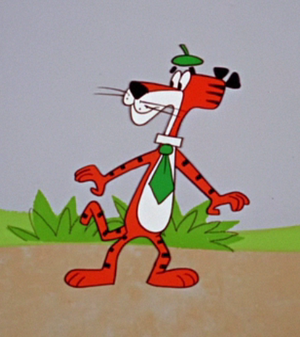Cool Cat (character)
- This article is about the character, for other uses see "Cool Cat".
| Cool Cat | |
|---|---|
 We have an imposter among us. A pale imitation even. | |
| Species | Tiger |
| Gender | Male |
| Affiliation | Colonel Rimfire |
| Father | Not mentioned |
| Mother | Not mentioned |
| Marital status | Single |
| First appearance | LT: Cool Cat (1967) |
| Played by | Larry Storch (1967-1969) Joe Alaskey (1996) Jim Cummings (1999-2000) Fred Tatasciore (2023) |
| File:S&TM Cool Cat.png The Sylvester & Tweety Mysteries | |
| File:TTL Cool Cat.png Tiny Toons Looniversity | |
Cool Cat is an anthropomorphic tiger and character in the Looney Tunes theatrical series, during the Warner Bros.-Seven Arts era. His voice was originated by Larry Storch.
Character description
Cool Cat is a bipedal tiger who wears a stylish green beret and necktie.
Appearances
TV series
Shorts
Biography
What's New Pussycat?
The Sylvester and Tweety Mysteries
Looniversity Years
Development
Following the restructuring of Warner Bros. Cartoons in 1967, company CEO Jack L. Warner hired animator Alex Lovy–an employee of Hanna-Barbera Productions–to handle the creation of new cartoon characters, in addition to supervising its last two classic stars Daffy Duck and Speedy Gonzales. The two characters Lovy invented were Cool Cat and Merlin the Magic Mouse,[1] the former of which was made to compete with DePatie–Freleng's Pink Panther series.[2]
Cool Cat also bears similarities to Hanna-Barbera's Snagglepuss; though, incidentally, there was an unsold pitch by the company for a television series called Toing Tiger, which would have starred a tiger that bore similarities with Snagglepuss.
Behind the scenes
- Cool Cat has the distinction of appearing in 1969's Injun Trouble, the last theatrical Looney Tunes cartoon in the golden age of American animation.
References
- ↑ Maltin, Leonard (1987). Of Mice and Magic: A History of American Animated Cartoons (Revised ed.). Plume. p. 276. ISBN 0-452-25993-2.
- ↑ Beck, Jerry (March 9, 2013). "The Last Days of 'Looney Tunes'". Cartoon Research.